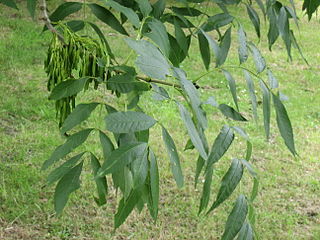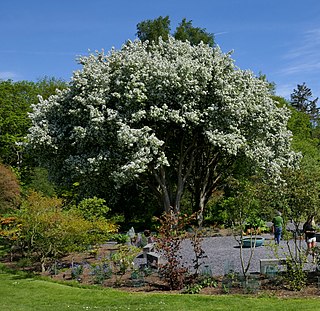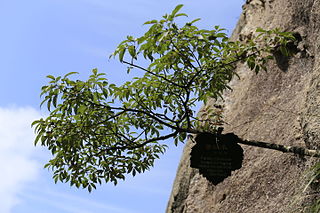
Fraxinus, commonly called ash, is a genus of plants in the olive and lilac family, Oleaceae, and comprises 45–65 species of usually medium-to-large trees, most of which are deciduous trees, although some subtropical species are evergreen trees. The genus is widespread throughout much of Europe, Asia, and North America.

Fraxinus americana, the white ash or American ash, is a fast-growing species of ash tree native to eastern and central North America.

Fraxinus excelsior, known as the ash, or European ash or common ash to distinguish it from other types of ash, is a flowering plant species in the olive family Oleaceae. It is native throughout mainland Europe east to the Caucasus and Alborz mountains, and Great Britain and Ireland, the latter determining its western boundary. The northernmost location is in the Trondheimsfjord region of Norway. The species is widely cultivated and reportedly naturalised in New Zealand and in scattered locales in the United States and Canada.

Pinus armandii, the Armand pine or Chinese white pine, is a species of pine native to China, occurring from southern Shanxi west to southern Gansu and south to Yunnan, with outlying populations in Anhui. It grows at altitudes of 2200–3000 m in Taiwan, and it also extends a short distance into northern Burma. In Chinese it is known as "Mount Hua pine" (华山松).

Fraxinus pennsylvanica, the green ash or red ash, is a species of ash native to eastern and central North America, from Nova Scotia west to southeastern Alberta and eastern Colorado, south to northern Florida, and southwest to Oklahoma and eastern Texas. It has spread and become naturalized in much of the western United States and also in Europe from Spain to Russia.

Fraxinus mandshurica, the Manchurian ash, is a species of Fraxinus native to northeastern Asia in northern China, Korea, Japan and southeastern Russia.

Fraxinus profunda, the pumpkin ash, is a species of ash (Fraxinus) native to eastern North America, where it has a scattered distribution on the Atlantic coastal plain and interior lowland river valleys from the Lake Erie basin in Ontario and New York west to Illinois, southwest to Missouri and southeast to northern Florida. It grows in bottomland habitats, such as swamps, floodplains and riverbanks. It is threatened by the emerald ash borer, an invasive insect which has caused widespread destruction of ash trees in eastern North America.

Malus hupehensis, common names Chinese crab apple, Hupeh crab or tea crabapple, is a species of flowering plant in the apple genus Malus of the family Rosaceae.

Dendrobium nobile, commonly known as the noble dendrobium, is a member of the family Orchidaceae. Dendrobium nobile is one of the most widespread ornamental members of the orchid family. It is the state flower of Sikkim.

Eriocapitella hupehensis, a species of flowering plant in the buttercup family Ranunculaceae, is native to Asia. The specific epithet hupehensis, which means "from Hupeh province, China", refers to a region where the species is known to occur. In Chinese, it is called dǎ pò wǎn huā huā (打破碗花花), which means "broken bowl flower".

Fraxinus floribunda is a species of ash native to South Asia, East Asia, and Southeast Asia. It is known from Afghanistan, Pakistan, Nepal, Assam, Bhutan, Laos, Myanmar (Burma), Thailand, Vietnam, the Ryukyu Islands, and parts of China.
Fraxinus berlandieriana, the Mexican ash, is a tree native to eastern and northeastern Mexico and to the south-central United States. It has been reported from Tamaulipas, Veracruz, Texas, New Mexico, Oklahoma, Louisiana and Mississippi.

Fraxinus cuspidata, the fragrant ash, is a tree native to northern Mexico and the southwestern United States. It has been reported from Nuevo León, Coahuila, Chihuahua, Tamaulipas, Texas, New Mexico, Arizona and Nevada.

Fraxinus griffithii, the Himalayan ash or evergreen ash is a species of flowering tree. It has been recorded in the Philippines, Indonesia, Vietnam, Myanmar, Taiwan, China, Bangladesh and India. This plant is commonly grown as an ornamental in Australia, where it is an invasive species.

Fraxinus xanthoxyloides, the Afghan ash or Algerian ash, is a species of ash tree. It is found from Morocco to China. Some authorities originally described the African specimens as a distinct species, Fraxinus dimorpha.

Fraxinus uhdei, commonly known as tropical ash or Shamel ash, is a species of tree native to Mexico and Central America. It is commonly planted as a street tree in Mexico and the southwestern United States. It has also been planted and spread from cultivation in Hawaii, where it is now considered an invasive species.

Fraxinus parryi, known by common names chaparral ash, crucecilla, and fresnillo, is a species of ash native to southwestern North America, growing as a shrub or a small tree.

Fraxinus insularis, the Chinese flowering ash or island ash, is a species of flowering plant in the family Oleaceae, native to central and southeastern China, Hainan, Taiwan, the Ryukyu Islands, and Yakushima, Japan. Its leaves produce a number of secoiridoid glucosides.
Fraxinus longicuspis, the taper-tip ash or Japanese ash, is a species of flowering plant in the family Oleaceae, native to the mountains of central and southern Japan. A deciduous tree, it is hardy to USDA zone 5. It is used as a street tree in a few cities around the world.
Fraxinus greggii, the littleleaf ash or Gregg's ash, is a species of flowering plant in the family Oleaceae, native to Texas and Mexico. A xerophytic shrub or scrubby tree reaching 6 m (20 ft), it is suitable for screens and containers. There is a cultivar, 'Libby Davison'.


















